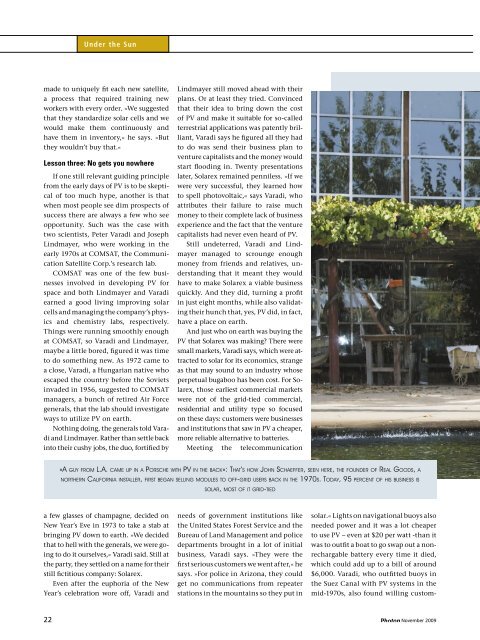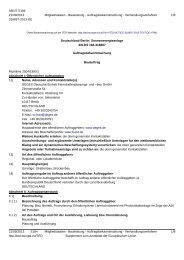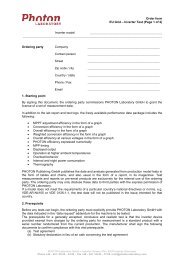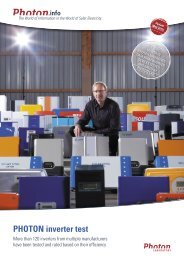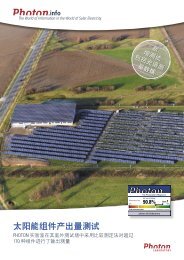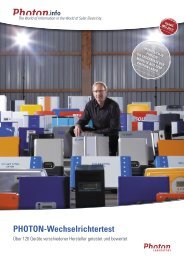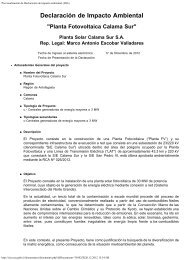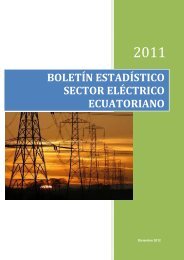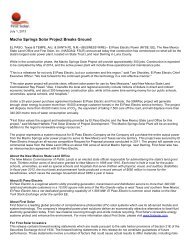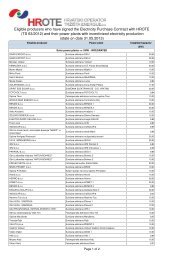INTRODUCTORY SPECIAL INTRODUCTORY ... - PHOTON Info
INTRODUCTORY SPECIAL INTRODUCTORY ... - PHOTON Info
INTRODUCTORY SPECIAL INTRODUCTORY ... - PHOTON Info
You also want an ePaper? Increase the reach of your titles
YUMPU automatically turns print PDFs into web optimized ePapers that Google loves.
Under the Sun<br />
made to uniquely fit each new satellite,<br />
a process that required training new<br />
workers with every order. »We suggested<br />
that they standardize solar cells and we<br />
would make them continuously and<br />
have them in inventory,« he says. »But<br />
they wouldn’t buy that.«<br />
Lesson three: No gets you nowhere<br />
22<br />
If one still relevant guiding principle<br />
from the early days of PV is to be skepti-<br />
cal of too much hype, another is that<br />
when most people see dim prospects of<br />
success there are always a few who see<br />
opportunity. Such was the case with<br />
two scientists, Peter Varadi and Joseph<br />
Lindmayer, who were working in the<br />
early 1970s at COMSAT, the Communi-<br />
cation Satellite Corp.’s research lab.<br />
COMSAT was one of the few busi-<br />
nesses involved in developing PV for<br />
space and both Lindmayer and Varadi<br />
earned a good living improving solar<br />
cells and managing the company’s phys-<br />
ics and chemistry labs, respectively.<br />
Things were running smoothly enough<br />
at COMSAT, so Varadi and Lindmayer,<br />
maybe a little bored, figured it was time<br />
to do something new. As 1972 came to<br />
a close, Varadi, a Hungarian native who<br />
escaped the country before the Soviets<br />
invaded in 1956, suggested to COMSAT<br />
managers, a bunch of retired Air Force<br />
generals, that the lab should investigate<br />
ways to utilize PV on earth.<br />
Nothing doing, the generals told Vara-<br />
di and Lindmayer. Rather than settle back<br />
into their cushy jobs, the duo, fortified by<br />
Lindmayer still moved ahead with their<br />
plans. Or at least they tried. Convinced<br />
that their idea to bring down the cost<br />
of PV and make it suitable for so-called<br />
terrestrial applications was patently bril-<br />
liant, Varadi says he figured all they had<br />
to do was send their business plan to<br />
venture capitalists and the money would<br />
start flooding in. Twenty presentations<br />
later, Solarex remained penniless. »If we<br />
were very successful, they learned how<br />
to spell photovoltaic,« says Varadi, who<br />
attributes their failure to raise much<br />
money to their complete lack of business<br />
experience and the fact that the venture<br />
capitalists had never even heard of PV.<br />
Still undeterred, Varadi and Lind-<br />
mayer managed to scrounge enough<br />
money from friends and relatives, un-<br />
derstanding that it meant they would<br />
have to make Solarex a viable business<br />
quickly. And they did, turning a profit<br />
in just eight months, while also validat-<br />
ing their hunch that, yes, PV did, in fact,<br />
have a place on earth.<br />
And just who on earth was buying the<br />
PV that Solarex was making? There were<br />
small markets, Varadi says, which were at-<br />
tracted to solar for its economics, strange<br />
as that may sound to an industry whose<br />
perpetual bugaboo has been cost. For So-<br />
larex, those earliest commercial markets<br />
were not of the grid-tied commercial,<br />
residential and utility type so focused<br />
on these days: customers were businesses<br />
and institutions that saw in PV a cheaper,<br />
more reliable alternative to batteries.<br />
Meeting the telecommunication<br />
»A g u y fr o m l.A. c A m e up in A po r s c h e wi t h pV in th e bA c k«: th At’s ho w Jo h n schAeffer, seen he r e, t h e fo u n d e r of re A l go o d s, A<br />
n o r t h e r n cAliforniA instAller, f i r s t be g A n selling mo d u l e s to of f-gr i d us e r s bA c k in th e 1970s. to d A y, 95 percent of hi s business is<br />
a few glasses of champagne, decided on<br />
New Year’s Eve in 1973 to take a stab at<br />
bringing PV down to earth. »We decided<br />
that to hell with the generals, we were go-<br />
ing to do it ourselves,« Varadi said. Still at<br />
the party, they settled on a name for their<br />
still fictitious company: Solarex.<br />
Even after the euphoria of the New<br />
Year’s celebration wore off, Varadi and<br />
s o l A r, m o s t of it gr i d-tied<br />
needs of government institutions like<br />
the United States Forest Service and the<br />
Bureau of Land Management and police<br />
departments brought in a lot of initial<br />
business, Varadi says. »They were the<br />
first serious customers we went after,« he<br />
says. »For police in Arizona, they could<br />
get no communications from repeater<br />
stations in the mountains so they put in<br />
solar.« Lights on navigational buoys also<br />
needed power and it was a lot cheaper<br />
to use PV – even at $20 per watt -than it<br />
was to outfit a boat to go swap out a non-<br />
rechargable battery every time it died,<br />
which could add up to a bill of around<br />
$6,000. Varadi, who outfitted buoys in<br />
the Suez Canal with PV systems in the<br />
mid-1970s, also found willing custom-<br />
November 2009


